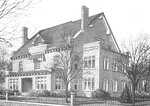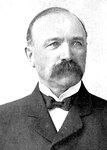

Seward’s historic Zimmerer House is now vacant and decaying, but it was once a showplace built by one of the town’s earliest businessmen, according to Joan Shurtliff of the Seward Genealogical Society.
However, Shurtliff believes a little care and imagination could turn the home into a tribute to a local pioneer.
The Jacobethan Revival style home was built in 1919-20 and is one of the largest single-family homes ever constructed in the area. It is three stories and contains more than 6,000 square feet of finished floor space. It was built of masonry construction with concrete floors and a brick exterior and is two blocks north of the Seward County Courthouse Square on Highway 15.
According to its National Register of Historic Places form, the mansion has a sunroom, three chimneys, a large red-tiled roof with side gables and the lot it rests on is surrounded by an ornamental fence with fire iron gates and 16 gate posts.
There is a two-story carriage house, also of masonry construction, adjacent to the home.
The home’s floor, doors and trim are made of oak, the foyer has oak paneling, there is an oak-beamed ceiling in one of the first-floor rooms and there is a built-in library and built-in hutch made of oak.
John Zimmerer, who Shurtliff described as a “mover and a shaker,” immigrated from Germany to the United States in 1868 when he was 14 years old. His brothers, Anton Zimmerer and William Bischof, had immigrated before him and were running a hardware store in Nebraska City, so he joined them in their venture.
Confident in their brother’s ability, Anton and William established a business in Seward in 1873 and put John in charge. In 1882, John bought the firm of Zimmerer & Bischof and ran it until 1900.
John married Philomena in 1881, and they adopted her nephew, also named John, after his mother died.
John became an officer in the First National Bank, Equitable Building and Loan Association and the Mutual Protective Fire Association. He was a charter member and active in St. Vincent de Paul Catholic Church, the Commercial Club, the Seward County Agricultural Society and the Social Welfare Society.
John served as Seward’s mayor for two years in the mid 1890s and was on the city council several times. According to the newspaper at the time, the “Seward Weekly Reporter,” some citizens were opposed to him being elected to a second mayoral term because he was Catholic.
In 1918, John built Seward’s first Ford dealership for his son to run on the corner of Sixth and Jackson streets. Then, he and Philomena began designing their mansion at 316 N. Sixth St.
Shurtliff said Lincoln architect George Berlinghof designed the home around 1919. Berlinghof had already designed the old Seward High School, Bee Public School, several Seward businesses and Our Redeemer Lutheran Church.
The couple lived in the home for a few years before John died in 1923 and Philomena followed in death 10 years later.
In 1936, the house was used as a medical clinic and hospital and minor plumbing and electrical changes were made to accommodate this.
It was sold to Concordia University in 1950 and converted into apartments. One first-floor doorway was closed, as was the back stairway. Bathroom and kitchen facilities were added and the front porch was enclosed to create additional interior space.
Shurtliff said the building was used as apartments up until about a year ago.
The home’s current owner, Sandra Pomerenke, has it up for sale for $500,000 through NAI FMA Realty.
According to the home’s National Register of Historical Places form, the impact of the changes it went through over the years was slight. The historical integrity of the home’s exterior and all of its major interior features remain intact.
Although the Zimmerer House is on the National Register of Historic Places, that does not mean it cannot be torn down if a future buyer makes that decision. However, Shurtliff believes it is a vital piece of Seward’s history and should be preserved.
“There are a lot of communities and towns all over the place that have old houses that are important to the community, and historically they get refurbished or taken care of, and they become like museums or the historical society gets them, or something,” she said. “For example, you’ve got the Bess Streeter Aldrich house in Elmwood, you've got the George Norris house in McCook. You've got the John Neihardt house in Bancroft.”
There are various maintenance issues with the house, specifically with the roof and ceilings, but Shurtliff said she hopes it can be repurposed as a meeting place, the home of the Genealogical Society, an annexation of the Civic Center or something similar.
“To restore a building like that is a labor of love,” Shurtliff said. “Financially, if you want to make money on the place, it's not a good idea. But, historically, it would be positive for the community.”